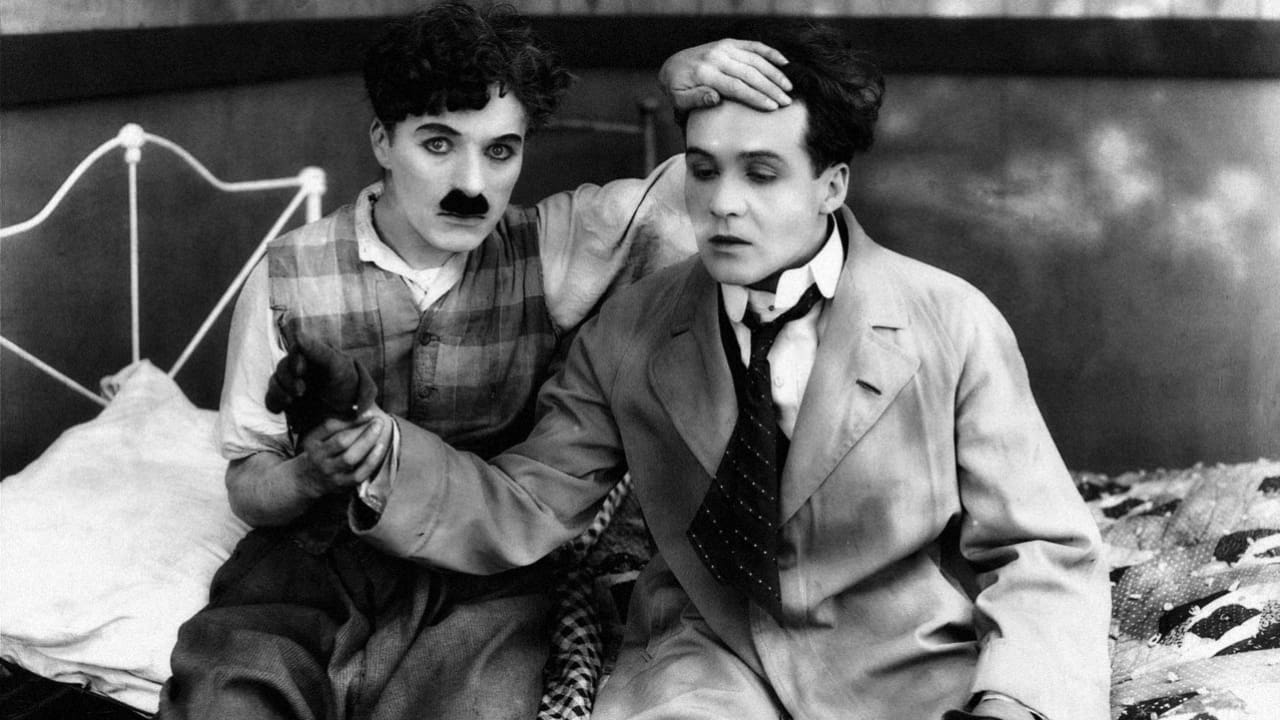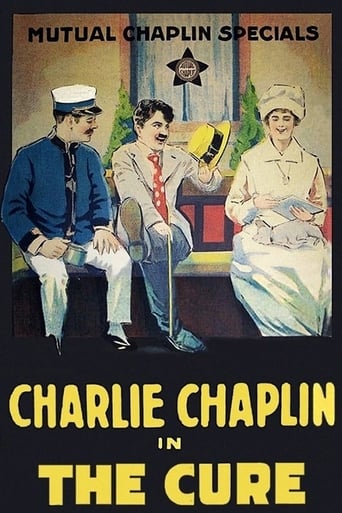



Strictly average movie
I gave this film a 9 out of 10, because it was exactly what I expected it to be.
View MoreIf you're interested in the topic at hand, you should just watch it and judge yourself because the reviews have gone very biased by people that didn't even watch it and just hate (or love) the creator. I liked it, it was well written, narrated, and directed and it was about a topic that interests me.
View MoreOne of the best movies of the year! Incredible from the beginning to the end.
View MoreTHE CURE (Mutual Studios, 1917), Written, directed and starring Charlie Chaplin, his tenth comedy short (20 minutes) for the Mutual studio, is one of his all time greats. For a title that indicates one to be set in a hospital with Charlie as an unruly patient who flirts with the nurses and drives his doctors crazy, in essence, it takes place in a sanitarium that wherever Charlie goes, trouble follows. For THE CURE, Chaplin breaks away from his traditional tramp character with derby and cane for straw hat, white suit and cane retained, stirring as much trouble as he can, intentionally or not, to those around him.The story opens at a resort with an assortment of female gossips gathered together seated around the health spring where enters the new resident, the drunken Charlie (Charlie Chaplin), arriving for a rest cure, to nearly fall into the water well on the ground. After being escorted to his room by a frail and thin bellboy, Charlie opens his crate that reveals an assortment of liquor bottles. Once the bottles are discovered with the bearded bellboy found drunk in Charlie's room, the superintendent (Frank J. Coleman) orders the bottles thrown out. The attendant (Albert Austin) takes him literally and throws the bottles out the window where they end up inside the water spring below. In the meantime, Charlie makes his rounds about the resort, encountering an attractive woman (Edna Purviance) being annoyed by the burly gout (Eric Campbell), thus, saving the day by becoming a big annoyance for the big man and hero to the girl. Later at the massage parlor, Charlie begins to have second thoughts of treatment when witnessing how the sadistic masseur (Henry Bergman) works on one of his customers. Following a series of unforeseen circumstances, Edna, whose about to meet with Charlie, discovers, to her disbelief, the refined residents and attendants having way too much fun for themselves in the lobby without knowing the reason why. And if that isn't enough!!!While there's not much plot nor character background development to go around, THE CURE is non-stop comedy, pure and simple. The carefully planned-out gags are enough to guarantee solid laughs with Chaplin stock character types in their proper roles for background support. As much as Chaplin is the sole attraction when it comes to both character and gags, Eric Campbell should not go unnoticed for his achievement in villainous comedy. Campbell, better known in later years as "Chaplin's Goliath," partakes in some of the greatest sight gags imaginable, including the revolving door, his reaction towards Charlie's misconducts involving his bandaged foot, his involvement with Charlie in both lobby and massage parlor, his trip down the stairs in a wheelchair, among others. Aside from Edna Purviance as Chaplin's frequent female co-star, other members of the cast include James T. Kelly, John Rand, Janet Miller Sully and Loyal Underwood.In the well documented three-part 1983 documentary, "Unknown Chaplin," there are some detailed moments capturing behind the scenes preparation for THE CURE, with Chaplin directing various sequences that were rehearsed and filmed, but not making it to the final print, and how changes to THE CURE developed into what has become one of Chaplin's finest gems, especially when properly scored on the musical soundtrack.When presented on public television in the sixties and seventies, this and other Chaplin's Mutual comedies (1916-17) were broadcast with sound effects and musical score taken from 1930s reissue prints. For THE CURE, underscoring consisted of current hit tunes of the day ranging from "Happy Feet" to "Happy Days Are Here Again." These reissue prints later became part of the Blackhawk/ Republic Home Video package dating back to the 1980s. In latter years, Chaplin's Mutual comedies were restored to accurate silent projection speed (25 minutes) with new orchestral score from KINO Video, the prints that have played on Turner Classic Movies (TCM premiere: December 6, 1999). After listening to different scores from various distributors, nothing comes off better than those orchestrated ones from Blackhawk for that bad scoring takes away the impact for such a fine comedy, considering how these twelve Chaplin shorts for Mutual are simply the cure for what ales you. (****)
View MoreThe Cure from 1917 is a Charles Chaplin film in which he doesn't play The Tramp character.He plays an alcoholic who enters a health spa with a big suitcase full of alcohol.There he meets a beautiful girl (Edna Purviance), who could help him become sober.At some point, all of the spa's inhabitants are loaded after the liquor ends up at the health waters.I have never been drunk in my entire life, and intend never to be, but it can be funny to watch comedians portraying drunkards on films.And Chaplin sure plays a funny drunk.And the absence of The Little Tramp isn't a problem, he was in that costume in many other movies.But how funny the movie is, that's the main issue here.And this movie is pretty funny.
View MoreChaplin heads to a spa, which was all the rage back in the day, in the tenth film he edited, wrote, produced, and directed for the Mutual Film Corporation. Although perceptions of alcoholism have changed significantly since Chaplin's time, the rising tide of the temperance movement was influential in passing the eighteenth amendment a couple years after this film was released. Alcoholism was perceived as more a battle of will power than environment or genetics. In The Cure, Chaplin descends on a health spa catering to the hoity-toity and creates chaos as usual. Instead of the tramp, we get Chaplin playing a regular character this time. Chaplin's character, like probably many real life people who went to these spas, has no intention of actually drying out. There are many moments of slapstick, sight gags, and poking fun at the high and mighty. Eric Campbell is on hand as a rich masher with gout. Edna Purviance plays the girl Chaplin helps of course. Henry Bergman plays the bathhouse masseuse as, what Chaplin's character perceives to be, a wrestler. This sequence builds laughs upon laughs and is uproarious, as Chaplin attempts to extricate himself from what he fears to be a very intimidating situation. Revolving doors also play a role in some terrific sight gags. Like many Chaplin films, the film starts slow and picks up as it goes along, an enjoyable departure from the tramp. *** of 4 stars.
View MoreCharlie, an alcoholic, goes to a health spa for the water cure. He does so, however, only half-heartedly since his luggage is filled almost entirely with alcohol. Once at the spa, he flirts with the always-delightful Edna Purviance and battles with always-menacing Eric Campbell, who finds himself at slight disadvantage in this film since his character suffers from gout. This film, Chaplin's tenth under his twelve-film Mutual contract, doesn't quite scale the heights of his previous one, "Easy Street," but remains one of his most consistently funny shorts. A revolving door is used repeatedly for great comic effect, but the highlight of the film is the massage sequence where Charlie desperately tries to avoid the rough treatment masseur Henry Bergman deals out. Charlie interestingly abandons his normal tramp persona for this film. Although he felt rich drinkers were ripe targets for comedy, he felt that alcoholism in the working class was a serious problem which wasn't suitable for comedy. (Don't ask me for attribution, but I know he said that somewhere.)
View More